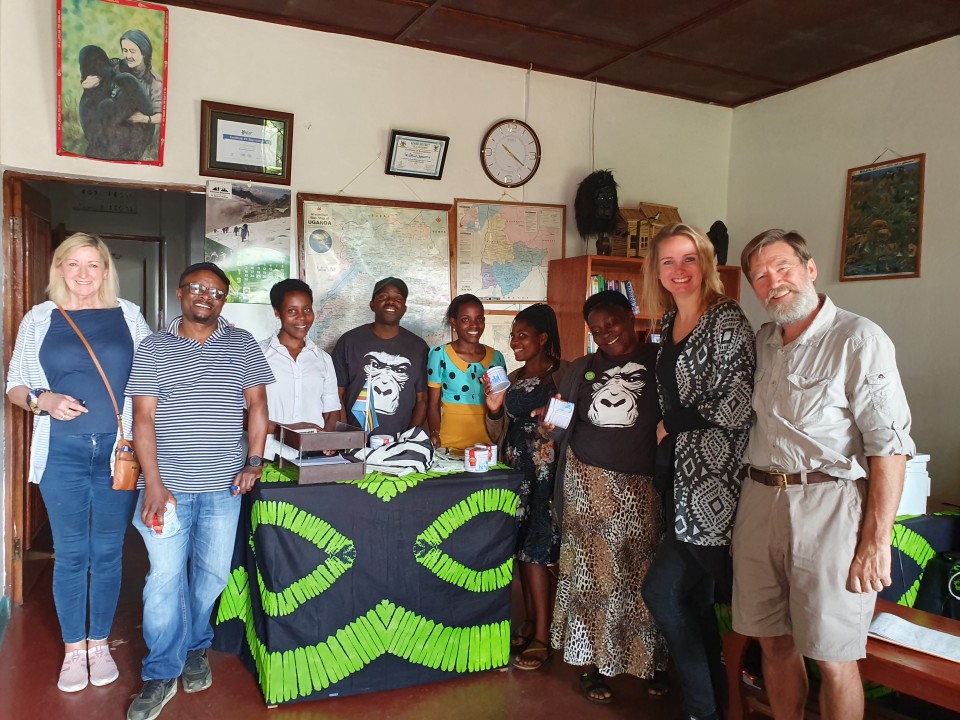
The story behind the story
A while ago, I had the chance to visit Rwanda and Uganda as part of a very special project – the book I co-authored with Chris Zadeh – Monkey Money Mind: a book that focuses on the psychology behind money and why we stop thinking when we start spending. Whenever I start speaking about Monkey Money Mind and my trip to Africa, many people immediately interrupt me to ask “What does Africa have to do with how we spend our money?”
When Chris and I first started writing the book, we agreed that we wanted to donate all the proceeds of the book to charity. We chose The Gorilla Organization (TGO) and once the decision was made official, Jillian Miller, its Executive Director, invited us to visit their projects in Rwanda and Uganda together with Dr. Ian Redmond OBE, former research assistant of Dian Fossey. That’s where the second part of our story begins.
But before we dive into the story, check out the short clip from our trip:
The Projects and Gorillas in the Mi(d)st
Myself and one of my colleagues, Carla Martinez, took off to Africa armed with all the cameras we could find. We were ready for the action, and that’s exactly what we got, and more. We arrived in Kigali, the capital of Rwanda and were immediately surprised. In the past decade or two, Rwanda has made some drastic changes – it switched its entire education system from French to English in no time so it could be more competitive globally. The roads were decent, good mobile signal throughout the country and there were tourists everywhere. Digitally modern and highly connected, they even use drones to distribute blood to medical emergency stations that are hard to reach. So far for the image we had (forgive our ignorance).
Excited about what was ahead of us, we couldn’t wait to kick it off. TGO created a jam-packed schedule, under the leadership of Dr. Samson Werikhe, that would allow Ohpen to meet their local TGO team and visit their main projects. Even though TGO works with communities in Uganda, Rwanda and Congo, our team only visited Rwanda and Uganda as the Democratic Republic of Congo was not safe to travel for us. Henry Cirhuzo, TGO’s project manager in Congo crossed the border to meet with us and shared the highlights of the projects he overlooks. But Henry is not the only one we met. Just to name a few, we met with TGO’s Uganda Field Officer, Regina Sanyu who introduced us to organic farmers, former poachers who used to depend on the forest. She has trained over 11.000 farmers in sustainable and organic gorilla-friendly agriculture. Now they are growing their own crops, eating from and selling them; schoolgirls who prepared a performance for us including poetry/storytelling and a powerful dance; and beekeepers who are making a living and a business out of their honey production. Everything they learn through the projects of TGO, they share with other people in their community. Each and every person we met had a different story, but a goal in common: building a better future for themselves and their families.
Besides the projects, a trek to see the gorillas in their natural habitat couldn’t be missed. We tracked them twice – once in Rwanda and once in Uganda. Visiting the projects and the gorillas taught us valuable lessons.
Trek 1: Mafunzo group (Rwanda)
The first trek took place in Rwanda. Guided by local guides and Dr. Ian Redmond, it took us 9,5 hours to get up to an altitude of 10,600 feet (3,200 meters) and come back down, covering over 18km of what used to be Dian Fossey’s home. Making it back after dark, the trek was no piece of cake. There were times we had to be assisted because of the thick jungle, the altitude and it was clear that we missed “leg-day” in the gym a couple of times. During the hike, Ian educated us about gorilla life, their habitat, families and the amazing history between him and this country that dates back to the seventies. After hours of hiking -Ian didn’t even break a sweat- we encountered the gorilla family, Mafunzo. Any pain we could have felt, dissipated to give way to pure awe mixed with adrenaline and the joy of seeing our furry cousins up close and personal. They say before you start that it is a magical encounter, and it truly is.
Trek 2: Nshongi group (Uganda)
During our second trek, we set out to meet the Nshongi group. This is a special group, as donors can adopt gorillas that belong to this group via The Gorilla Organization’s website. We set out on this adventure with three delegates of TGO: Rwanda and Uganda Programme Manager, Dr Samson Werikhe, Safia and Jovia. This trek didn’t take us as long as the first one but seeing the Nshongi family was every bit as impressive as meeting the Mafunzo one. A striking difference, though, was the vegetation; it seemed to be much more diverse in Uganda when compared to Rwanda. A comment made by the porters stood out to us; they all used to live inside of the parks but in order to create an income that did not depend on poaching or taking wood from the forest, they are now on a rotating schedule where once a month they can assist tourists who visit the gorillas. They are given $15/$20 per person for helping out one day. That money supports the porters for an entire month.
Out of Africa: Key takeaways from our visit to Rwanda and Uganda
When I look back at my journey to Africa, a journey that started long before I actually set foot there, I can say that I learnt so much during our trip that one blog cannot do it justice. Although I could write another book on the experience alone, I tried to jam my top takeaways from our journey here and from meeting all the lovely people we met:
- We all want the same thing: a better future. That is what drives us and connect us. For example, one of the most inspirational stories we heard during our trip was from a beekeeper. She received her training as a beekeeper from TGO and received two hives. From the sales of the honey produced by her hives, she was able to buy a goat. She used the manure of her goat for her own garden and crops, then she combined the money from the sale of honey and crops to invest in more beehives. Now, she owns more than 20 beehives, her goat has had 5 babies and she is planning on expanding her honey business to make wax and candles. All made possible by TGO who train and educate the community. In the end, no matter how much we have, where we come from, what we look like, where we live or what our income level is, we want to do and be better.
- The butterfly effect IS real. We learned how big the influence of the Western world is over these countries. For example, we learned about the Pyrethrum fields in Rwanda. Heavily supported by the European Union, more than half of Rwanda’s national park was reduced to cultivate this flower, which produces pesticide that is then exported and sold to the rest of the world. Rwanda and Tanzania alone make up for 75% of the world’s supply. The EU provided millions of euros between 2003 and 2010 to, among other projects, privatize tea and Pyrethrum. The European Development Fund advised to demolish one-third of the 160 km2 park for a cattle project that would generate income, swapping ‘useless’ forest income for income-producing cattle. Reducing the forest had a great impact not only on the gorillas but on other species that live in the forest. In Rwanda there are no more forest elephants left. This means that there are no large animals to ‘plant trees’ with the seeds via their dung. Everything we do has an impact and putting our needs above everything else no matter what, can have dire consequences in the long run. If we want to build a sustainable future, we need to fight short-termism: destroying our natural resources, in this case, the forest, to use it for projects that will generate income faster.
- We can all make a difference: we get to decide whether that will be good or bad. it doesn’t matter what level of income we have, we can always pay attention to our environment and try to do the least damage possible. And, if we can afford it, we can always donate to a good cause such as TGO. You can read more about why we chose TGO, in my previous post: APESTRUCK: An exploration of the psychology of money (and ultimately giving back).
We can do so much more with less
TGO doesn’t give money away or bring volunteers from abroad to help. Instead, they prefer to invest in local communities and projects – both by hiring local people, training them and getting them involved in their sustainability projects so they in turn can spread the word and train others, creating a domino effect and minimizing the dependence on the forest and increase efforts in protecting it. I saw firsthand how resourceful you can be when you don’t have much at hand. The idea is to try to look at our silver linings and make the most out of everything we have in everything we do to create a better future.
Until now we were able to donate €31.084,22 to The Gorilla Organization from the book proceeds and donations from friends, family and colleagues from Ohpen. Thank you all!
A special thanks to Melvin Siau, Marco Bos, Jan Fekkes, Sabrina Vanstaen, Laurens Wijnker, Linda Reijling, Ronald Mul, Carlo Velthuijs, Frederieke Hoogstins, Bas Doeksen, Denise Scheermeijer, Kees Postma, Ineke Schouten, Michiel Schipperus, Eelco Ouwerkerk, Victor van Osta, Ohpen and Laura Bron for your donations. Do you want to know more or donate to The Gorilla Organization? Please click here.
